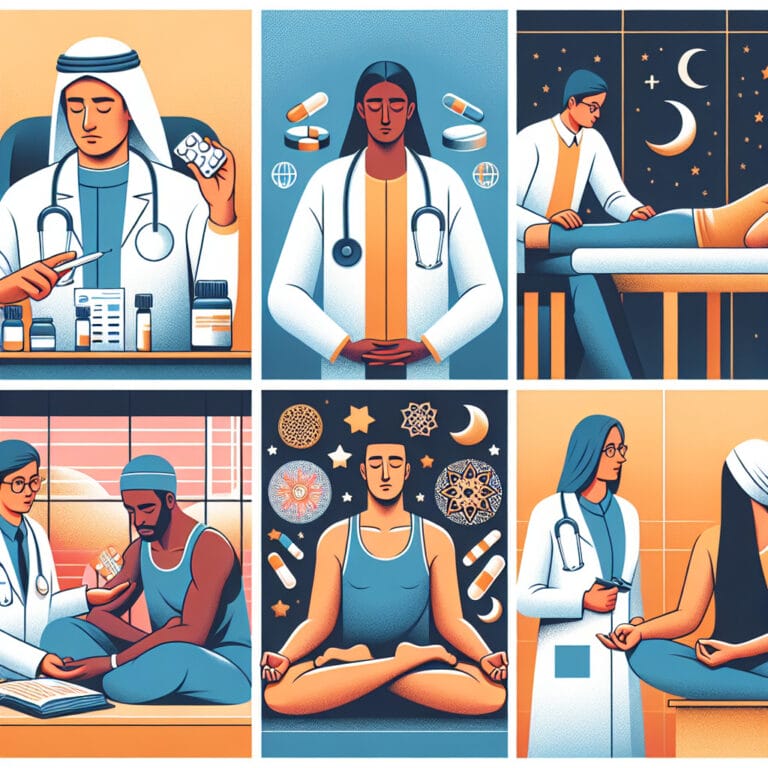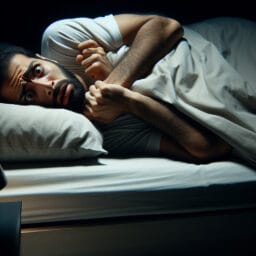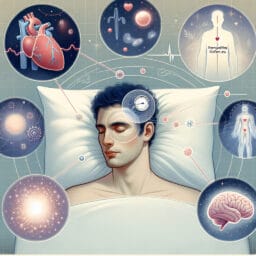
Understanding Parasomnia: Definition, Causes, and Treatments
Table of Contents
- Introduction
- Definition of Parasomnia
- Causes of Parasomnia
- Types of Parasomnia
- Treatments for Parasomnia
- Conclusion
- Frequently Asked Questions
Introduction
A surprising fact about parasomnia is that it can encompass a range of disruptive sleep disorders, including night terrors, REM sleep behaviour disorder, and even confusional arousals. These disorders often disrupt sleep and lead to abnormal movements or verbal activity during various stages of the sleep cycle. For instance, non-REM parasomnias occur during deep sleep when individuals may experience partial arousals leading to actions like walking or eating unconsciously. On the other hand, REM parasomnias happen during rapid eye movement (REM) sleep where muscle paralysis typically occurs; however, people with REM sleep behavior disorder might act out intense dreams due to lack of this paralysis.
Understanding these nuances becomes crucial as different types of parasomnias have diverse causes – from stress and certain medical conditions to neurodegenerative diseases or family history. In young children particularly, night terrors are common but usually outgrown with time. Yet in adults dealing with recurrent nightmares or undesired behaviours like ‘sleep sex’, it calls for professional help from experts in sleep medicine.
Managing parasomnia involves addressing underlying issues such as obstructive sleep apnea if present and implementing good ‘sleep hygiene’. This includes sticking to a consistent bedtime routine for falling asleep and maintaining a conducive sleeping environment. In severe cases where safety is a concern or there’s detailed recall of potentially harmful events upon awakening, treatments could involve medications like tricyclic antidepressants or therapies guided by professionals using tools like a ‘sleep diary’. With proper understanding and treatment strategies for these complex disorders called parasomnias – we can aim for undisturbed restful nights devoid of undesirable physical events disrupting our slumber.
Definition of Parasomnia
Parasomnia, often misunderstood as purely a sleep disorder, is a complex condition with innumerable variations that can significantly disrupt an individual’s sleeping patterns. It involves abnormal movements or behaviors such as sleep-related eating disorders and confusional arousals which occur either at the onset of sleep or during the various stages of the sleep cycle. Deep into the realm of REM and non-REM parasomnias, we encounter instances like REM Sleep Behaviour Disorder where individuals may act out their dreams due to an absence of normal muscle paralysis typically associated with this stage of rapid eye movement (REM) sleep.
Contrary to common belief, parasomnia isn’t limited merely to night terrors in young children but expands its spectrum to involve other manifestations like ‘sleep sex’ or Sleep-Related Abnormal Sexual Behaviors (SASB). Moreover, parasomnias are caused not just by stress or lifestyle factors; they also have roots in neurological disorders and neurodegenerative diseases. Some instances could be triggered by existing medical conditions such as obstructive sleep apnea where repeated disruptions in breathing during deep sleep can lead to partial arousals from non-REM sleep.
To navigate such complexities requires expertise within the field of Sleep Medicine. This discipline aids in understanding different types of parasomnias better – their causes including potential genetic predispositions linked with family history, effective treatments ranging from medication (like tricyclic antidepressants) to therapies guided by tools like a ‘sleep diary’. This comprehensive approach thus helps provide appropriate management strategies for patients dealing with these potentially disruptive and distressing conditions.
Causes of Parasomnia
Delving deeper into the intricacies of parasomnias, it becomes evident that this sleep disorder is far more than a singular condition – it’s an umbrella term encompassing diverse manifestations such as nightmare disorder, confusional arousals and REM sleep behaviour disorder. Each type of parasomnia takes place at different stages in the sleep cycle, either during deep sleep (non-REM stage) or rapid eye movement REM sleep. Studies have shown that both environmental and psychological factors can play significant roles in triggering these disruptive episodes. For example, excessive stress or trauma may lead to recurrent nightmares or post-traumatic stress disorder impacting one’s ability to fall asleep peacefully.
Genetic predispositions are also a key aspect when considering causes for conditions like REM Sleep Behavior Disorder (RBD), where individuals act out potentially harmful behaviors due to lack of normal muscle paralysis during REM sleep stage. A detailed family history often aids professionals in diagnosing such instances, highlighting how essential these underlying factors can be.
Moreover, medical conditions like obstructive sleep apnea – characterized by interrupted breathing during deep non-REM sleep – can cause partial arousals leading to confusional arousal or even unusual actions such as ‘sleep sex’. Hence managing parasomnias requires a multi-faceted approach combining good ‘sleep hygiene’, possibly medication adjustments if current medications disrupt sleep patterns and professional guidance from experts within the field of Sleep Medicine who use tools like ‘sleep diary’ for effective treatment strategies. Through comprehensive understanding and treatment approaches, we pave the way towards overcoming such disruptive disorders.
| Type of Parasomnia | Stage of Sleep Cycle | Possible Causes | Potential Treatment |
|---|---|---|---|
| Nightmare Disorder | REM Sleep | Excessive stress, trauma | Stress management, professional guidance, sleep diary |
| Confusional Arousals | Deep Sleep (non-REM stage) | Interrupted breathing due to conditions like sleep apnea | Managing underlying medical conditions, good sleep hygiene, medication adjustments |
| REM Sleep Behaviour Disorder (RBD) | REM Sleep | Genetic predispositions | Professional guidance, detailed family history, possibly medication adjustments |
| ‘Sleep Sex’ | Deep Sleep (non-REM stage) | Interrupted breathing due to conditions like sleep apnea | Managing underlying medical conditions, good sleep hygiene, professional guidance |
Types of Parasomnia
It’s noteworthy that parasomnia is not a single entity but rather a broad term that covers various sleep disorders, all of which cause abnormal movements and behaviours during sleep. These disruptive sleep-related disorders can occur at any stage of the sleep cycle and often lead to undesirable physical events or verbal activity. Sleepwalking, nightmares, and confusional arousals are examples of non-REM parasomnias, occurring during deep sleep stages where partial arousals may happen. In contrast, REM parasomnias like REM Sleep Behaviour Disorder (RBD) occur during rapid eye movement (REM) periods when people typically experience muscle paralysis – yet in RBD this fails to take place leading to actions being acted out from intense dreams.
Sleep paralysis is another intriguing type of parasomnia; individuals wake up unable to move or speak even though they are conscious – a potentially terrifying experience often accompanied by hallucinations. Exploding Head Syndrome is also classed as a parasomnia where sufferers hear loud noises such as bangs or explosions as they are falling asleep or waking up. The causes behind these complex conditions vary widely ranging from stress and medical conditions like obstructive sleep apnea to neurodegenerative diseases and family history linked with genetic predispositions.
Deconstructing these mysteries requires expertise from the field of Sleep Medicine which aids in understanding these disorders better through tools like the ‘sleep diary’ for tracking sleeping patterns, changes in current medications if those disrupt sleep quality and implementing good ‘sleep hygiene’. It’s crucially important that individuals experiencing recurrent nightmares or other signs of potential parasomnias seek help for preventing sleep deprivation and enhancing their overall wellbeing.
| Type of Parasomnia | Description | Occurrence | Potential Causes |
|---|---|---|---|
| Non-REM Parasomnias (e.g., Sleepwalking, Nightmares, Confusional arousals) | Abnormal movements and behaviors during deep sleep stages with partial arousals. | During deep sleep stages | Stress, Medical conditions, Neurodegenerative diseases, Genetic predispositions |
| REM Sleep Behaviour Disorder (RBD) | Occurs during REM when muscle paralysis typically happens, but fails, leading to actions acted out from intense dreams. | During rapid eye movement (REM) sleep | Stress, Medical conditions, Neurodegenerative diseases, Genetic predispositions |
| Sleep Paralysis | Individuals wake up unable to move or speak even though they are conscious. Often accompanied by hallucinations. | Upon waking up | Stress, Medical conditions, Neurodegenerative diseases, Genetic predispositions |
| Exploding Head Syndrome | Sufferers hear loud noises such as bangs or explosions as they are falling asleep or waking up. | During transition to sleep or upon waking up | Stress, Medical conditions, Neurodegenerative diseases, Genetic predispositions |
Treatments for Parasomnia
While many perceive parasomnias as mere night terrors or sleep paralysis, these terms barely skim the surface of this perplexing sleep disorder spectrum. Parasomnias, in essence, represent a realm of disruptive sleep-related disorders marked by abnormal movements and actions such as confusional arousals and REM Sleep Behaviour Disorder, that happen during various stages of the sleep cycle; deep non-REM sleep and rapid eye movement (REM) sleep respectively. Unveiling their complexity requires tools from Sleep Medicine like ‘sleep-diary’ for tracking changes in sleeping patterns or current medication effect on them.
Moreover, treatments can span from lifestyle modifications encapsulating good ‘sleep hygiene’ to medicines like tricyclic antidepressants for more severe instances. For example, obstructive sleep apnea – a medical condition often triggering parasomnia – requires specialized management strategies to prevent further disruptions in sleeping patterns and associated risks.
Interestingly, genetic predispositions too can play significant roles with family history highlighting potential causes for conditions like REM Sleep Behavior Disorder where individuals act out potentially harmful behaviors due to lack of normal muscle paralysis during REM stage. Insight into neurological disorders causing confusional arousal also helps professionals tailor suitable treatment plans ensuring patient safety while addressing recurring nightmares or undesired behaviours such as ‘sleep sex’. In essence, comprehensive understanding with targeted action paves the path towards overcoming parasomnias.
Conclusion
In the complex web of sleep disorders, parasomnias stand out due to their perplexing nature involving abnormal movements and verbal activities during sleep. They span from non-REM parasomnias like night terrors in young children to REM Sleep Behaviour Disorder (RBD) where lack of muscle paralysis during REM sleep leads to individuals acting out potentially harmful actions from intense dreams. Notably, obstructive sleep apnea can trigger these conditions by disrupting deep sleep stages leading to partial arousals and confusional arousal. Expertise in Sleep Medicine offers valuable insights into managing these disruptive disorders using tools like a ‘sleep diary’ for tracking patterns or adjusting current medications that may disrupt sleep cycles. Additionally, maintaining good ‘sleep hygiene’, addressing underlying medical conditions and taking tricyclic antidepressants in severe cases form part of comprehensive treatment strategies. Understanding these intricate dynamics paves the way for better management of parasomnia, thereby enhancing our overall wellbeing by preventing sleep deprivation.


